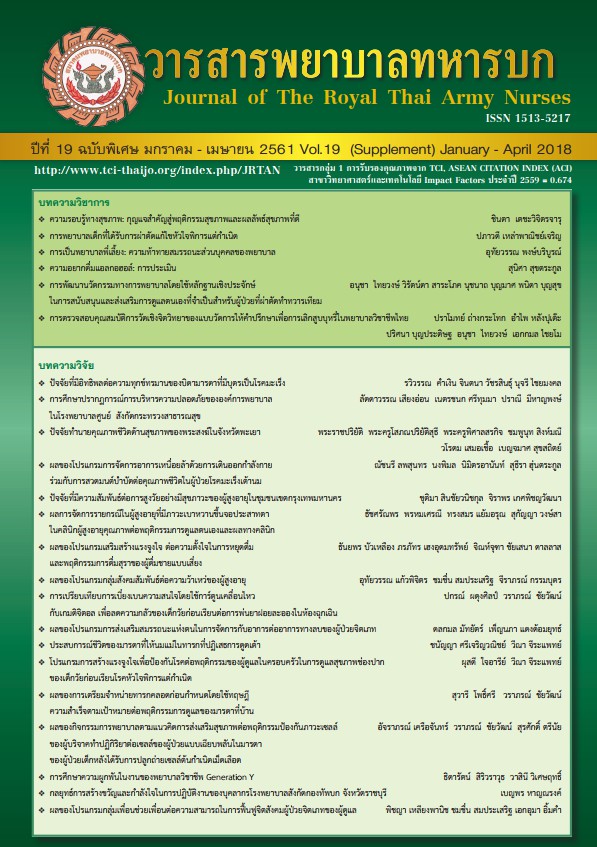The Effectiveness of Innovation that Promoted Fall Prevention Behavior among Elderly
Keywords:
Fall Prevention Innovation, Fall Prevention Behaviors, ElderlyAbstract
The quasi-experimental research aimed to study The effectiveness of innovation that promoted fall prevention behavior among elderly. It was used the one group pre-test and post-test Design among 400 elderly in Bangkok Province using simple random sampling. PRECEDE Frame work was used as a conceptual framework in this study. The experimental group was received 4-week of innovation that promoted fall prevention behavior developed by the researcher. Innovation used information technology augmented reality (AR) through wall-mounted media using via smartphones to promote awareness, physical exercise skills and reinforcement from closed person and public health person. Data were collected before and after the experiment by using the Questionnaires which were developed by researcher. There were consisting of 3 parts: (1) biosocial data, (2) predisposing factors, enabling factors, reinforcing factors, and (3) a fall prevention behavior. Content validity of the questionnaires was verified by the 3 experts. The reliability of the second part and 3rd parts were 0.790, 0.732, 0.802, and 0.712 respectively. The Data were analyzed by using the percentage, mean, standard deviation, and dependent samples t-test.
The results of the study showed that after participating in the Promoting Fall Prevention Behavior Innovation, the experimental group had higher mean scores on a fall prevention behavior than the baseline at a .05 statistical significance level.
Downloads
References
Bangkok. Text and Journal Publication Co.,Ltd. 2014. (in Thai)
2. Department of Health.ANNUAL REPORST 2014. n.p. 2014. (in Thai)
3. Krulish, L.H., & Anemaet, W. K. Fall risk assessment and prevention in home care. Home Health Care Management Practice, 2008. 20(2):
169-174.
4. Friedman, S.M., Munoz, B., West, S.K., Rubin, G.S., & Fried, L.P. Fall and fear for Primary and secondary prevention. The American Geriatrics
Society, 2002. 20(8): 1329-1335.
5. Loipha S. Older people with Information technology. Journal of Information Science. 2011. 29(2): 53-64. (in Thai)
6. Jiravarapong B. AR: Augmented Reality. Journal of Education Naresuan University. 2010. 12(3): 189-194. (in Thai)
7. Kuei-Fang Hsiao & Habib F. Rashvand. Data modeling mobile augmented reality: integrated mind and body rehabilitation; Springer Science+Business Media New York. 2013. 74(10): 3543-3560.
8. Becker, M.H. and L.A. Maiman. “The Health Belief Model: Origins and Correlation In Psychological Theory,” Health Education Monographs. 1974.
2(4): 336-353.
9. Thiya N. Fall Prevention Related Behavior Among Elder Patients Seeking Treatment at Female Trauma Ward pf Pramongkutklao Hospital. Master of Science (Health Education), Kasetsart University. 2008. (in Thai)
10. Malahom R. The Effect of Health Belief Theory with Social Support on Fall Prevention among the Elderly in Pho Sai District, UbonRatchathani Province.The thesis of Master degree, Mahasarkarm University. 2011. (in Thai)
11. Ketpetch P. An Application of Health Belief Model and Social Support for Falling Prevention Among Elderly in Chaoprayayomraj Hospital, SuphanBuri Province. The Thesis of Master degree, Mahasarkarm University. 2010. (in Thai)
12. Kittipimpanon K, Amonatsatsue K, Kerdmongkol P, Maruo SJ, & Nitayasuddhi D. Development and Evaluation of a Community-based Fall Prevention Program for Eldery Thais. Pacifc Rim International Journal of Nursing Research, 2012; 16(3): 222-235.
13. Chanjirawadee P., Sirisopon N., Kainaka P., Onsiri S. The Effectiveness of a Fall Prevention Program for a Fall Prevention Behaviors in Hypertension Elderly. Journal of The Royal Thai Army Nurses, 2017; 18 (Suppl 2). 41-48. (in Thai)
14. Sorysang L, Khompraya J, Natetanasombut K. A Study of Fall Prevention Guideline in Older Adult Living in Mitraphappatana Community. Journal of The Royal Thai Army Nurses. 2014; 15(1): 122-129. (in Thai)
Downloads
Published
How to Cite
Issue
Section
License
บทความหรือข้อคิดเห็นใดใดที่ปรากฏในวารสารพยาบาลทหารบกเป็นวรรณกรรมของผู้เขียน ซึ่งบรรณาธิการหรือสมาคมพยาบาลทหารบก ไม่จำเป็นต้องเห็นด้วย
บทความที่ได้รับการตีพิมพ์เป็นลิขสิทธิ์ของวารสารพยาบาลทหารบก
The ideas and opinions expressed in the Journal of The Royal Thai Army Nurses are those of the authors and not necessarily those
of the editor or Royal Thai Army Nurses Association.






